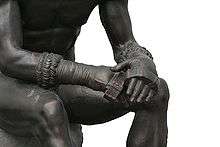Cestus

A cestus or caestus is an ancient battle glove, sometimes used in pankration. They were worn like today's boxing gloves, but were made with leather strips and sometimes filled with iron plates or fitted with blades or spikes, and used as weapons.
Terminology
.jpg)
The word caestus is Latin, a deverbal noun derived from the verb caedere, meaning "to strike", and can be reasonably translated as "striker". The Latin plural is caestūs, since this is a fourth declension noun;[1] whereas cestus in the second declension (nominative plural cestī) means a girdle or belt.[2] Nevertheless, cesti has sometimes been used.[3] In English, "cestuses" can be used.[4]
Early Greek cestuses
The first cestuses in Ancient Greece were used in boxing-like competitions. Called meilichae (μειλίχαι), these gloves consisted of strips of raw hide tied under the palm, leaving the fingers bare.[5]
The Greeks also invented a variation called the sphaerae (σφαῖραι), which were sewn with small metal balls covered with leather.[5]
Roman cestuses
The Roman variant included straps of different lengths, many reaching to the elbow, in order to protect the forearm when guarding heavy blows.[5] Caestūs were frequently used in Roman gladiatorial bouts, both against each other and against other weapon-wielding gladiators. Despite being seemingly outmatched by other types of gladiators, a single hit from a cestus would have incapacitated most fighters.[6] The cestus-fighter would have otherwise had no body armour.[7]
Cestus-fighters were mostly slaves, who fought to the death. Caestūs boxing was eventually abolished in 393 AD due to excessive brutality.[8]
Boxer of Quirinal

The most famous depiction of cestuses is the Hellenistic sculpture The Boxer of Quirinal. The sitting figure is wearing cestuses on his hands. It is part of the permanent collection of the National Museum of Rome.[9]
See also
References
- ↑ Charlton Lewis and Charles Short (1966). A Latin Dictionary. Oxford University Press.
- ↑ "Latin Word Study Tool". tufts.edu.
- ↑ Stefano De Caro The National Archaeological Museum of Naples 1996 "119971 This statue, found in 1899 among the remains of a gymnasium, represents a boxer (note the cesti or thongs armed with metal studs, on his hands)."
- ↑ "cestus". TheFreeDictionary.com.
- 1 2 3
 Chisholm, Hugh, ed. (1911). "Caestus". Encyclopædia Britannica (11th ed.). Cambridge University Press.
Chisholm, Hugh, ed. (1911). "Caestus". Encyclopædia Britannica (11th ed.). Cambridge University Press. - ↑ "Martial Arts of the World: R-Z". google.ca.
- ↑ "Roman Helmets". google.ca.
- ↑ Gary Holland. "History of London Boxing: Early Boxing History". BBC. Retrieved 23 November 2015.
- ↑ "Boxer of Quirinal". uni-graz.at.